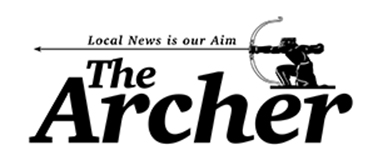Contributing Copy and Photographs
The Archer welcomes contributions from members of the community. We regret that, due to the large amount of correspondence we receive, we cannot guarantee an individual reply to every contribution.
Submitting Copy
Avoid fancy fonts. Use of Times new Roman 11 pt throughout would be best as that is what the paper uses. Don't use styles, or centre, tabs or indent.
Avoid spaces. Don't use more than one space between words or sentences or leave spaces at end of paragraphs, as they only have to be removed by hand. No underlining. Put non-printing comments within the text into italics and between curly brackets. Put printing comments into italics.
Unusual spellings. If you use a word or phrase that might be misconstrued as a typo, such as an unusual spelling of a common name, put {sic} after it so it isn't inadvertently "corrected". Proper names please check and double check — it makes The Archer look ignorant and discourteous if these are spelled incorrectly.
Consistency. The Archer has developed its own in-house style for grammar and punctuation for the sake of consistency and this should (as far as possible) be followed for all original copy.
Tagging. Each article should have a tag for convenience. It should consist of up to two keywords that sum up the content of the article, not the title. Linked articles such as an introduction would have the same tag followed by a qualifier such as intro. Regular articles keep the same keywords but followed by issue date, such as Nov02, as qualifier. Images that form part of the article should share the same tag (with serial number if more than one) and caption tags should be the same as the image tag with cap added. Always use the tag for the file name. Related articles have related tags.
Laying out your copy
Top line. Always start with the article tag (same as file name) and, if possible the word count, on the top line. Word counts if given should exclude any non-printing comments.
Instructions. Then give any comments or instructions and list any associated images and their captions, using their tags. Note: If you state that an image is essential, then the copy won't get printed without it. If there's not enough space, or no caption for image with acknowledgements, the article will be pulled. Leave a separator of two blank lines before starting your article proper, and then lay it out as follows:
Article line 1. give your preferred headline (or title), (don't use all caps, underline, bold etc.)
Article line 2. give the by-line, starting with By and giving the author. Even if you don't want it printed, provide it anyway in case you need to be consulted about changes, but add {don't print}.
Article lines 3 onwards. are the body of the article, each paragraph starting a new line.
Providing copy on disk or by email
Do not embed images but supply as a separate file, tagged as explained above. Here are suggested Archer file preferences; if you want to use other formats please check first:
Text
Preferred file formats .RTF, .DOC or .WPD . (rtf is preferred as it has a smaller file size and can be read into any word processor, or directly into the DTP).
Photographic images
Please provide the original, raw, un-processed images (original colour if available) for the Archer to crop and enhance. Preferred file formats JPG or TIFF
Diagrams and logos
If creating a scan or screen-shot, use GIF or TIF format.
If originally created on computer the format of the original program may be preferable, but please consult the Archer over details, including fonts.
Captions
These can be created in WordPad, Note Pad or your word processor and saved as a TXT file. Always provide a separate caption for each image, and include acknowledgement.
